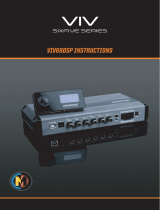
38
6.6. Function list 6.6. Lista de funciones
1. Channel 1 volume, VOL 1. Volumen canal 1, VOL
2. Input 1 Signal presence, SP 2. Indicador de presencia de señal en entrada 1, SP
3. Channel 1 Clip indication, CLIP 3. Indicador de recorte canal 1, CLIP
4. Channel 2 volume, VOL 4. Volumen canal 2, VOL
5. Input 2 Signal presence, SP 5. Indicador de presencia de señal en entrada 2, SP
6. Channel 2 Clip indication, CLIP 6. Indicador de recorte canal 2, CLIP
7. Channel 3 volume, VOL 7. Volumen canal 3, VOL
8. Input 3 Signal presence, SP 8. Indicador de presencia de señal en entrada 3, SP
9. Channel 3 Clip indication, CLIP 9. Indicador de recorte canal 3, CLIP
10. Channel 4 volume, VOL 10. Volumen canal 4, VOL
11. Input 4 Signal presence, SP 11. Indicador de presencia de señal en entrada 4, SP
12. Channel 4 Clip indication, CLIP 12. Indicador de recorte canal 4, CLIP
13. Channel 5 volume, VOL 13. Volumen canal 5, VOL
14. Input 5 Signal presence, SP 14. Indicador de presencia de señal en entrada 5, SP
15. Channel 5 Clip indication, CLIP 15. Indicador de recorte canal 5, CLIP
16. Channel 6 volume, VOL 16. Volumen canal 6, VOL
17. Input 6 Signal presence, SP 17. Indicador de presencia de señal en entrada 6, SP
18. Channel 6 Clip indication, CLIP 18. Indicador de recorte canal 6, CLIP
19. Power switch and pilot light, POWER 19. Interruptor y piloto de puesta en marcha, POWER
20. Mains socket 20. Base de red
21. Output terminals channel 6, CH6 21. Terminales atornillables salida 6, CH 6
22. Output terminals channel 5, CH5 22. Terminales atornillables salida 5, CH 5
23. Output terminals channel 4, CH4 23. Terminales atornillables salida 4, CH 4
24. Output terminals channel 3, CH3 24. Terminales atornillables salida 3, CH 3
25. Output terminals channel 2, CH2 25. Terminales atornillables salida 2, CH 2
26. Output terminals channel 1, CH1 26. Terminales atornillables salida 1, CH 1
27. XLR input connector 6, IN6 27. Conector XLR entrada 6, IN6
28. XLR input connector 5, IN5 28. Conector XLR entrada 5, IN5
29. XLR input connector 4, IN4 29. Conector XLR entrada 4, IN4
30. XLR input connector 3, IN3 30. Conector XLR entrada 3, IN3
31. XLR input connector 2, IN2 31. Conector XLR entrada 2, IN2
32. XLR input connector 1, IN1 32. Conector XLR entrada 1, IN1
33. Ground terminal, GND 33. Terminal de masa, GND
34. Fuse holder 34. Portafusible
35. Electrical ground / mechanical ground 35. Conmutador de desconexión masa eléctrica/masa
disconnection switch, GND LINK mecánica, GND LINK
36. Stereo / bridge channel 5/6 switch, ST/BRIDGE 36. Conmutador stereo bridge canal 5/6, ST/BRIDGE
37. Channel 6 / link channel 4 switch, IN6/LINK CH4 37. Conmutador canal 6 / link canal 4, IN6/LINK CH4
38. Channel 5 / link channel 3 switch, IN5/LINK CH3 38. Conmutador canal 5 / link canal 3, IN5/LINK CH3
39. Stereo / bridge channel 3/4 switch, ST/BRIDGE 39. Conmutador stereo bridge canal 3/4, ST/BRIDGE
40. Channel 4 / link channel 2 switch, IN4/LINK CH2 40. Conmutador canal 4 / link canal 2, IN4/LINK CH2
41. Channel 3 / link channel 1 switch, IN3/LINK CH1 41. Conmutador canal 3 / link canal 1, IN3/LINK CH1
42. Stereo / bridge channel 1/2 switch, ST/BRIDGE 42. Conmutador stereo bridge canal 1/2, ST/BRIDGE
43. Channel 2 / link channel 1 switch, IN2/LINK CH1 43. Conmutador canal 2 / link canal 1, IN2/LINK CH1
44. Channel 1 / channel 1 + channel 2 switch, 44. Conmutador canal 1/ canal1+ canal 2,
IN1/IN1+IN2 IN1/IN1+IN2


















